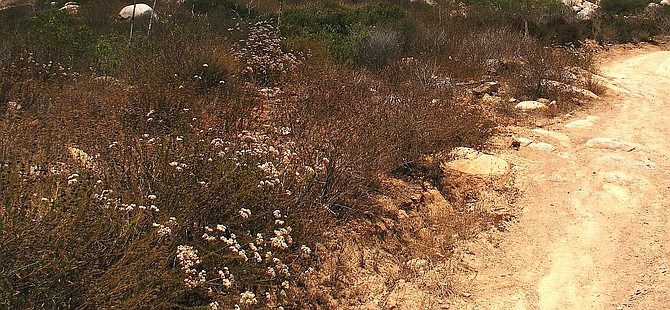 Facebook
Facebook
 X
X
 Instagram
Instagram
 TikTok
TikTok
 Youtube
Youtube

San Diego’s Coastal Wildflower Bloom continues on north-facing slopes and in shady canyon bottoms, where the sun’s drying effects have not yet taken hold, look for native red monkeyflower, blue-eyed grass, wild hyacinth, and nonnatives such as chrysanthemum and mustard. Irrigated freeway embankments, with showy African daises, blooming ice-plant, and other forms of groomed landscaping continue to exhibit brash coloration.

Chamise and Buckwheat, two of the most common native flowering plants in San Diego County’s sage-scrub and chaparral plant communities, are in flower this month through June. Chamise, also known as greasewood, readily sprouts from root crowns after fire. The stems of chamise and buckwheat are tipped by clusters of small white or cream-colored flowers, fading to russet-brown by July. Near the coast look for flat-top buckwheat, common on south-facing slopes. Here it shares space with other low-growing sage-scrub plants like black sage and California sagebrush.

Wild Lilac (ceanothus) is currently blooming mostly at elevations higher than 4000 feet in San Diego County. Blossom colors range from pure white to shades of blue or lavender. Some fine examples may be seen along the upper Noble Canyon Trail in the Laguna Mountain Recreation Area atop Mt. Laguna.
These spring evenings, the long, dim sea serpent Hydra snakes far across the southern sky. Find Hydra's head, a rather dim asterism about the width of your thumb at arm's length, in the southwest. It's lower right of Regulus by about two fists at arm's length. Also, a line from Castor through Pollux points to it about two and a half fists away. Hydra's tail stretches all the way to Libra rising in the southeast. Hydra's star pattern, from forehead to tail-tip, is 95° long. That's more than a quarter of the way around the celestial sphere.
The above comes from the Outdoors listings in the Reader compiled by Jerry Schad, author of Afoot & Afield in San Diego County. Schad died in 2011. Planet information from SkyandTelescope.org.


San Diego’s Coastal Wildflower Bloom continues on north-facing slopes and in shady canyon bottoms, where the sun’s drying effects have not yet taken hold, look for native red monkeyflower, blue-eyed grass, wild hyacinth, and nonnatives such as chrysanthemum and mustard. Irrigated freeway embankments, with showy African daises, blooming ice-plant, and other forms of groomed landscaping continue to exhibit brash coloration.

Chamise and Buckwheat, two of the most common native flowering plants in San Diego County’s sage-scrub and chaparral plant communities, are in flower this month through June. Chamise, also known as greasewood, readily sprouts from root crowns after fire. The stems of chamise and buckwheat are tipped by clusters of small white or cream-colored flowers, fading to russet-brown by July. Near the coast look for flat-top buckwheat, common on south-facing slopes. Here it shares space with other low-growing sage-scrub plants like black sage and California sagebrush.

Wild Lilac (ceanothus) is currently blooming mostly at elevations higher than 4000 feet in San Diego County. Blossom colors range from pure white to shades of blue or lavender. Some fine examples may be seen along the upper Noble Canyon Trail in the Laguna Mountain Recreation Area atop Mt. Laguna.
These spring evenings, the long, dim sea serpent Hydra snakes far across the southern sky. Find Hydra's head, a rather dim asterism about the width of your thumb at arm's length, in the southwest. It's lower right of Regulus by about two fists at arm's length. Also, a line from Castor through Pollux points to it about two and a half fists away. Hydra's tail stretches all the way to Libra rising in the southeast. Hydra's star pattern, from forehead to tail-tip, is 95° long. That's more than a quarter of the way around the celestial sphere.
The above comes from the Outdoors listings in the Reader compiled by Jerry Schad, author of Afoot & Afield in San Diego County. Schad died in 2011. Planet information from SkyandTelescope.org.
Comments